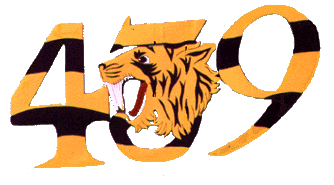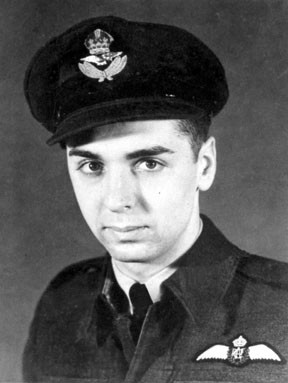|
History
of
 Squadron Squadron
  
Chapter
VI
Winter in the Netherlands
November 1944 January
1945
|
Both Tiffie
pilots remarked that the enemy aircraft, coloured light blue, were very
dirty and so streaked with oil that it was difficult to see the crosses
on the fuselage. The enemy were quite aggressive and "seemed
to want to mix it";
but they were the first to break off the engagement. After the combats
the Typhoons flew on to Eindhoven only to find it unserviceable, so they
turned north to Volkel. Only three landed there. F/O
S. Angelini, number four in the section, was last heard from when he
reported that he had ten gallons of fuel left. Two days later his body
was found in the wreckage of his aircraft near Rips, not far from Deurne.
Bullet holes all around the cockpit showed that Sammy had gone down fighting. He had made 14 sorties in the six weeks that he had been with the squadron. Early in December he had gone to England to pick up a replacement aircraft and had been weatherbound there until the last day of the month. He was lost on his first sortie after returning to
Eindhoven.
|

Photo
Courtesy of F/O S. Angelini's Family
|
Intentionally
left blank
|
On the morning of 1 January No. 439 Squadron's
aircraft strength was nine Typhoons, two of which were temporarily unserviceable as a result of damage sustained the previous day. Of the nine, one was lost in air combat during the day, another was burned out in the Luftwaffe strafe and a third was slightly damaged, reducing the serviceability state to four.
So that operations could continue six Tiffies were temporarily transferred from No. 44O, which had suffered most severely in the blitz. Replacements were flown in as quickly as possible, but flak casualties almost kept pace with replacements and it was not until 3 February that the
squadron regained its full establishment of 18 aircraft.
Nevertheless operations continued when the weather permitted. Five hours after the Luftwaffe storm had shaken the airfield No. 439 put up its four serviceable aircraft on an armed recce over the American front. Near St. Vith F/L Carr found a hole in the clouds through which he led his section in an attack on seven vehicles grouped about a house among some trees by the roadside. Three of
the trucks went up in flames and two more were damaged. A 40 mm.
shell, however, blew "quite a hole" in the starboard wing of
Johnny's aircraft one more kite U/S!
|
|
Luckily the next two days were very cloudy and hazy, giving the overworked maintenance sections an opportunity to catch up with the backlog or repairs. Three new aircraft were received and two of the damaged Typhoons were made serviceable again, giving the squadron a total of nine (out of ten) machines ready for operations. The six which had been borrowed from No. 440 were returned to it, before there had been an opportunity to use them on operations. On 4 and 5 January the squadron was able to work again at al most normal capacity, making 34 sorties on five armed
recces. The situation to the south had eased by this time and only one of the shows was over the Aachen St. Vith area. Clouds pressing down upon the hills made it impossible to rind any targets; nor did the four recces into the northern area between,
Bocholt, Munster, Rheine and Hengelo have much better luck. With two exceptions they reported no movement seen on the ground; one exception was a lone locomotive which S/L
Crosby and his section left spouting steam, and the other was a pair of vehicles which were damaged on a road north of
Borken. Twice some enemy activity was noted in the air, a line of six Me. 163s and a gaggle of FW. 190s and Me. 109s; but the enemy
"wouldn't
play" and pulled out of range of the Typhoons.
  
Copyright
©1998-2016 Michael T. Melnick. All rights reserved
the
unofficial homepage of  Tiger
Squadron Tiger
Squadron
.
.
|
|